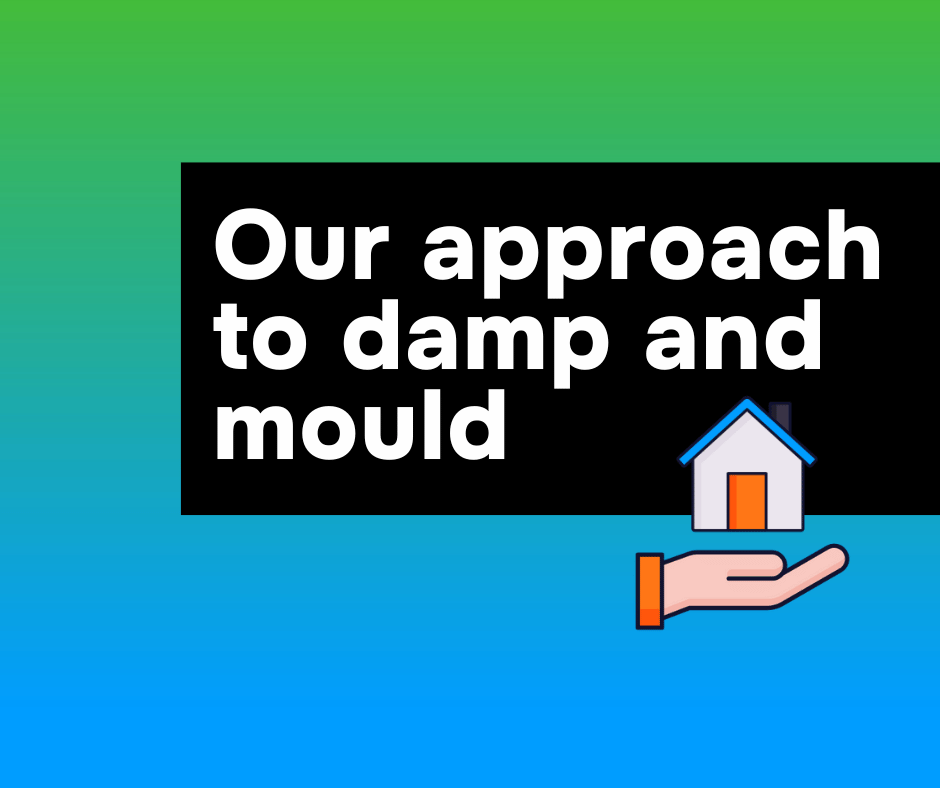More than 60,000 customers live in our 30,000 homes, and their health and safety is our number one priority. Everyone has the right to live safely and comfortable in their homes.
We have always taken issues around damp and mould extremely seriously and over the past year we have adopted a new customer focussed, proactive and empathetic approach to tackling damp and mould in people’s homes.
Last year, we completed 15,830 damp and mould repairs to 2868 homes, following the completion of a damp and mould survey, this could be anything from full preservation work, washing down mould and fixing draughts. We currently have 3065 properties in our after care process where by works have been completed. We also have a further 197 properties which have now been closed, with no reports of damp and mould returning.
We want to keep getting quicker at resolving these issues as we hear about them. We don’t always get this right, but we’re working really hard to improve the speed and experience of this work for customers ahead of the implementation of Awaab's Law.
What improvements have we made so far?
Customer focussed
In 2023 we introduced a new Damp and Mould Policy, using the zero-tolerance principle of the 2021 Housing Ombudsman Spotlight report. We also worked with customers to create a new, customer-friendly damp and mould procedure that details the steps we will follow when we receive a report of damp or mould.
We introduced a Customer Relationship Management (CRM) system which means colleagues have a full view of every interaction we have with customers, including repairs, complaints and communication preferences. We also introduced a dedicated case management process, so customers have one point of contact to deal with throughout their repair getting fixed and to provide aftercare to make sure all issues are sorted. As part of this process, we log the category of risk and severity as a repair is reported.
This year, we also produced new damp, mould and condensation guidance, including a leaflet for customers, offering advice on how to report, deal with, spot the signs of and treat damp, mould or condensation.
Dedicated resource
We introduced a dedicated damp and mould telephone line (0191 525 5500), and we recruited extra colleagues and set up a specialist Damp and Mould Team to support more calls, inspections and remedial works. This meant we were able to introduce a rapid response clean down within 48 hours of damp and mould being reported to reduce the risk of the most severe reports.
Maintenance teams were also moved from a ‘trade based’ approach to an ‘area’ approach to offer a consistent personal service for customers. This means one maintenance manager and one assistant maintenance manager oversees a geographical area of homes, meaning they can be more familiar with customers and the properties in their area.
Knowledge is key
We reinforced an ‘every visit counts’ approach for all staff, and frontline colleagues completed dedicated awareness training to proactively look for signs of damp and mould when visiting a customer’s home. Relevant teams also completed Chartered Institute of Environmental Health Damp and Mould training to identify and treat damp and mould, and we continue to upskill and train colleagues with external partners.
To make sure we know as much as possible about our homes and ensure our property data is always up to date, each stock condition survey includes an inspection of the home to identify visible signs of damp and mould. An Empty Homes Surveyor will also visit empty properties and carry out a damp and mould assessment before they are allocated to a new customer.
We have also looked at hotspot areas for damp and mould so that we could target inspections and property investment towards those areas. This includes a loft top-up programme and an improved specification of mechanical extractions in kitchen/bathroom improvements.
As part of our aftercare process, case coordinators check in with customers 8 weeks and 12 months after work has been completed to confirm there has been no return of damp and mould.
Since adopting this new approach, customers have expressed their satisfaction with the quick response times for cleaning down cases of damp and mould and with having one point of contact throughout the process. From our Tenant Satisfaction Measures, which are collected by an independent agency, we know that 82% of customers are satisfied that their home is safe and 78% of customers are satisfied with repairs and we want those scores to continue to improve as we continue to work on providing the best service for customers.
We want to address all instances of damp and mould with the urgency and proactivity they demand. We will continue to engage with customers, provide training to our colleagues, upskill frontline teams, and take proactive measures to identify and resolve cases as early as possible.
Our teams are working hard to resolve all damp and mould, but there are occasions where we don’t know about issues with a customers’ home, or we do know, and we don’t tackle it as quickly as we would like.
We never want customers to feel unhappy with conditions in their home and encourage any customers with concerns or worries about damp and mould to contact our dedicated damp and mould hotline on 0191 525 5500.
What happens when you report damp and mould?
- When damp and/or mould is first reported, our contact centre triage the case with the customer. Based on the answers provided the case is given a severity rating.
- The case is allocated to a Case Coordinator who is responsible for overseeing and progressing all aspects of the case, including repairs appointments, investigatory work communication with the customer and the aftercare process.
- Based on the outcome of the severity rating, a mould wash down or damp inspection will be raised and booked within the priority timescales.
- Following the wash down or inspection appointment, we will log a job to resolve any issues identified during the initial visit.
- Our Case Coordinators will monitor all repairs and once they are complete, then move the case into our aftercare process.
- Four to six weeks after the case was moved into aftercare one, the Case Coordinator will contact the customer to check if the issues with the damp and mould have been resolved or if it has returned. If resolved, the case is moved into aftercare two, which involves the Case Coordinator contacting the customer 10 to 12 months later to check our intervention has fully resolved the damp and mould. If at any point the damp and mould return during either period of aftercare the case is moved back into the inspection and repairs phase of the process and further actions agreed with the customer.



